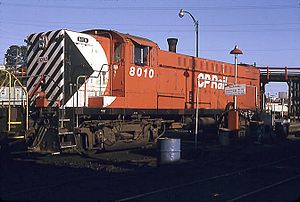- Multimark
-
The Multimark was introduced by Canadian Pacific Railway on July 17, 1968 to identify each of its various operations.
Composition
Each operation was assigned a different colour while taking on a new identity. For instance:
- CP Rail (Red)
- CP Transport (Blue)
- CP Express (also Blue)
- CP Ships (Green)
- CP Telecommunications (Yellow Ochre)
- CP Air (Orange)
- CP Hotels (Gray)
The Multimark was made up of a triangle, suggesting motion or direction. In contrast, a circle suggests global activities and a square suggests stability. The Multimark was also known by railfans as Pacman for its resemblance to the early video game symbol.
Industry Changes
The Multimark was gradually done away with in the 1980s as the various entities of Canadian Pacific Limited changed names. CP Air became Canadian Pacific Airlines and was later sold off. CP Hotels became Canadian Pacific Hotels and Resorts and much later sold off. CP Express & Transport went out of business due to deregulation. CP Telecommunications was merged into CN-CP Telecommunications which soon went of business due to the changing industry. Unitel was then created to acquire what remained. CP Ships became Canadian Pacific Ships and was finally sold off in 2005. In January 1991 with the acquisition of Delaware and Hudson Railway, a bankrupt US railroad, CP Rail became known as CP Rail System, a marketing name that included Soo Line Railroad which had become 100% owned. (CPR had long had controlling interest in it).
The Multimark on CP Rail slowly faded away with no official announcement. September 1987 saw the first diesel to be repainted without it, a GP7 yard engine, 1684.
References
Spanner July–August 1968 A special edition of the employee magazine dedicated entirely to the corporate changes.
Categories:
Wikimedia Foundation. 2010.

